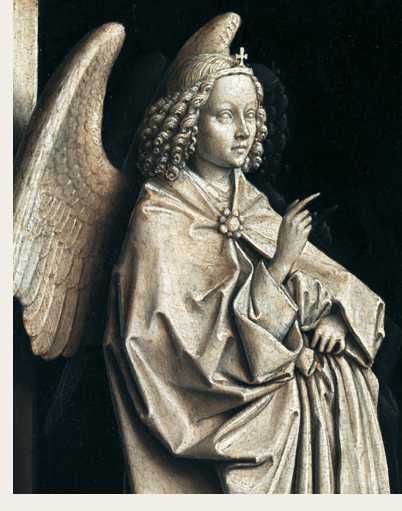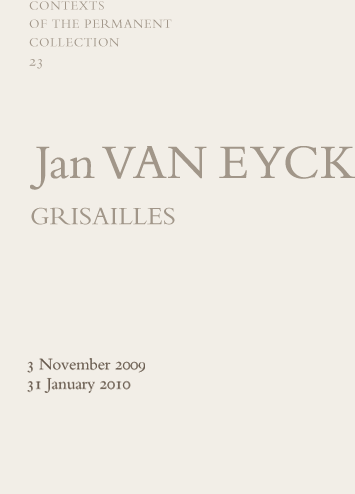
cat. 1
Jan Van Eyck
Diptych of the Annunciation, c. 1435-1440
The Archangel Gabriel (left panel detail)
Museo Thyssen-Bornemisza, Madrid
Jan Van Eyck
Diptych of the Annunciation, c. 1435-1440
The Archangel Gabriel (left panel detail)
Museo Thyssen-Bornemisza, Madrid


The exhibition Contexts of the Permanent Collection 23 presents an overview of selected works in grisaille, a technique which experienced its heyday in the 14th and 15th centuries and was highly popular in the Netherlands. Among the great masters who practised the art of grisaille was Jan van Eyck, and his famous Annunciation Diptych, owned by the Thyssen-Bornemisza Museum, constitutes the focal point of this exhibition.
Jan van Eyck (Maaseick, c. 1390-Bruges, 1441) is a central figure in the history of art. The beginnings of the career of this accomplished manuscript illuminator and painter are largely a mystery; his exact date of birth and his artistic training are just two of many unknown details about his early life. The first documents that mention him date from 1422, when he entered the service of John III, Duke of Bavaria and Count of Holland. After the death of this ruler, the artist moved to the court of Philip the Good, Duke of Burgundy, whom he served as painter, valet de chambre and ambassador. He lived in Lille, but by 1430 he was documented as residing in Bruges, where he married, set up a productive workshop and died in 1441. Jan van Eyck was a true master of the art of painting, and his works are characterised by an unprecedented realism and the use of optical illusions.
This exhibition aims to underscore the popularity and importance that the grisaille phenomenon acquired in the 14th and 15th centuries. For this reason, the project offers an overview of carefully selected pieces executed in black and white and using very different techniques and media, and it brings together examples from a variety of disciplines such as painting, drawing, miniatures, sculpture and textiles. These pieces illustrate and explore the origin, acceptance and progress of grisaille in this period. The tour begins with the splendid Annunciation Diptych by Jan van Eyck, property of the Thyssen-Bornemisza Museum [cat. 1]. In this work, the artist deliberately renounced the use of all colour and executed the composition by applying black and white tones, creating the illusion of a group of sculptures—and this in an era when painters and sculptors were engaged in fierce competition to assert the supremacy of their respective art forms. Van Eyck is also represented by another exceptional work: the Saint Barbara from the Koninklijk Museum voor Schone Kunsten in Antwerp [cat. 2], whose physical appearance has sparked a heated controversy among critics and experts. Hans Memling is also present in the exhibition with his Annunciation from the collection of the Groeningemuseum in Bruges, where the master uses colour only in certain areas of the composition [cat. 3]. In Jacques Daliwe’s Liber Picturatus, visitors can examine two drawings done in silverpoint, the Annunciation and the Coronation of the Virgin [cats. 4 and 5], which were used as workshop models and are currently kept at the Berlin Staatsbibliothek.
The thematic thread continues with grisailles found in illuminated codices and manuscripts, such as the Psalter of Bonne of Luxembourg by the miniaturist Jean Le Noir (active c. 1331-1380) from the Metropolitan Museum of Art in New York (The Cloisters) [cat. 6]. This is followed by the Bible Historiale by Jan Baudolf (active 1368-1381), from the Museum Meermanno-Westreenianum in The Hague [cat. 7], the Wiesbaden Codex from the Hessisches Hauptstaatsarchiv [cat. 8] created by the famous illuminator and sculptor André Beauneveu (c. 1335-c. 1401) in collaboration with his workshop and other artists, and the Catalogus abbatum Bertinensium from the collection of the Bibliothèque de l’Agglomération of Saint-Omer [cat. 9]. The books of hours on display include an outstanding specimen attributed to the so-called Masters of the Delft Grisailles [cat. 10] and the Book of Hours of Philip the Good, Duke of Burgundy by Jean Le Tavernier and followers (active 1434-1460) [cat. 11], both from the Koninklijke Bibliotheek in The Hague. The work of Dreux Jean (Master of the Girart de Roussillon, died c. 1467) can be contemplated in his illustrations for Saint Augustine’s Soliloquia [cat. 12]. This section concludes with two magnificent works by the celebrated artist Simon Marmion (c. 1425-1489): the Book of Hours of Guillaume Rolin [cat. 13] from the Biblioteca Nacional de España in Madrid, and another book of hours from the Museo Civico d’Arte Antica, Palazzo Madama, in Turin [cat. 14].
In order to illustrate the widespread existence of monochrome sculptures in alabaster and the role they played in these kinds of depictions, two carvings have been included in the exhibition. One of them is a Virgin Mary by an anonymous Flemish master from the Kunstkammer collection of the Vienna Kunsthistorisches Museum [cat. 17], which was once part of an Annunciation group. The other is an Apostle [cat. 16] by the workshop of the Master of Rimini from the Memling collection at the Sint Jans-Hospitaalmuseum.
The exhibition concludes with a beautiful Mitre used in funeral rites [cat. 18] from the workshop of Jean d’Orléans (Master of the Narbonne Altarcloth, active in 1361, died in 1416/1425) contributed by the Musée de Cluny in Paris.
Jan van Eyck (Maaseick, c. 1390-Bruges, 1441) is a central figure in the history of art. The beginnings of the career of this accomplished manuscript illuminator and painter are largely a mystery; his exact date of birth and his artistic training are just two of many unknown details about his early life. The first documents that mention him date from 1422, when he entered the service of John III, Duke of Bavaria and Count of Holland. After the death of this ruler, the artist moved to the court of Philip the Good, Duke of Burgundy, whom he served as painter, valet de chambre and ambassador. He lived in Lille, but by 1430 he was documented as residing in Bruges, where he married, set up a productive workshop and died in 1441. Jan van Eyck was a true master of the art of painting, and his works are characterised by an unprecedented realism and the use of optical illusions.
This exhibition aims to underscore the popularity and importance that the grisaille phenomenon acquired in the 14th and 15th centuries. For this reason, the project offers an overview of carefully selected pieces executed in black and white and using very different techniques and media, and it brings together examples from a variety of disciplines such as painting, drawing, miniatures, sculpture and textiles. These pieces illustrate and explore the origin, acceptance and progress of grisaille in this period. The tour begins with the splendid Annunciation Diptych by Jan van Eyck, property of the Thyssen-Bornemisza Museum [cat. 1]. In this work, the artist deliberately renounced the use of all colour and executed the composition by applying black and white tones, creating the illusion of a group of sculptures—and this in an era when painters and sculptors were engaged in fierce competition to assert the supremacy of their respective art forms. Van Eyck is also represented by another exceptional work: the Saint Barbara from the Koninklijk Museum voor Schone Kunsten in Antwerp [cat. 2], whose physical appearance has sparked a heated controversy among critics and experts. Hans Memling is also present in the exhibition with his Annunciation from the collection of the Groeningemuseum in Bruges, where the master uses colour only in certain areas of the composition [cat. 3]. In Jacques Daliwe’s Liber Picturatus, visitors can examine two drawings done in silverpoint, the Annunciation and the Coronation of the Virgin [cats. 4 and 5], which were used as workshop models and are currently kept at the Berlin Staatsbibliothek.
The thematic thread continues with grisailles found in illuminated codices and manuscripts, such as the Psalter of Bonne of Luxembourg by the miniaturist Jean Le Noir (active c. 1331-1380) from the Metropolitan Museum of Art in New York (The Cloisters) [cat. 6]. This is followed by the Bible Historiale by Jan Baudolf (active 1368-1381), from the Museum Meermanno-Westreenianum in The Hague [cat. 7], the Wiesbaden Codex from the Hessisches Hauptstaatsarchiv [cat. 8] created by the famous illuminator and sculptor André Beauneveu (c. 1335-c. 1401) in collaboration with his workshop and other artists, and the Catalogus abbatum Bertinensium from the collection of the Bibliothèque de l’Agglomération of Saint-Omer [cat. 9]. The books of hours on display include an outstanding specimen attributed to the so-called Masters of the Delft Grisailles [cat. 10] and the Book of Hours of Philip the Good, Duke of Burgundy by Jean Le Tavernier and followers (active 1434-1460) [cat. 11], both from the Koninklijke Bibliotheek in The Hague. The work of Dreux Jean (Master of the Girart de Roussillon, died c. 1467) can be contemplated in his illustrations for Saint Augustine’s Soliloquia [cat. 12]. This section concludes with two magnificent works by the celebrated artist Simon Marmion (c. 1425-1489): the Book of Hours of Guillaume Rolin [cat. 13] from the Biblioteca Nacional de España in Madrid, and another book of hours from the Museo Civico d’Arte Antica, Palazzo Madama, in Turin [cat. 14].
In order to illustrate the widespread existence of monochrome sculptures in alabaster and the role they played in these kinds of depictions, two carvings have been included in the exhibition. One of them is a Virgin Mary by an anonymous Flemish master from the Kunstkammer collection of the Vienna Kunsthistorisches Museum [cat. 17], which was once part of an Annunciation group. The other is an Apostle [cat. 16] by the workshop of the Master of Rimini from the Memling collection at the Sint Jans-Hospitaalmuseum.
The exhibition concludes with a beautiful Mitre used in funeral rites [cat. 18] from the workshop of Jean d’Orléans (Master of the Narbonne Altarcloth, active in 1361, died in 1416/1425) contributed by the Musée de Cluny in Paris.
